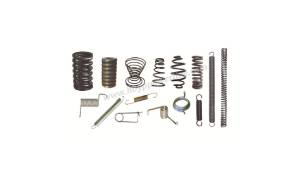1. Overview of power cable lines
Power cable line composition:
a. Cable body (generally referred to as cable)
b. Attachment-intermediate connector (the key point is to restore the structure of the cable body)
Terminal head (indoor, outdoor, plug-in)
c. Other installation equipment (bridge, pipe, arson material, etc.)
Cable transmission characteristics: The high-voltage transmission line is isolated by a solid insulator and sealed inside a grounded metal shield.
Overhead transmission characteristics: high-voltage transmission lines are separated by air insulators, and the ground is the ground electrode)
conductor
The conductor is the path that provides the load current. Its main technical indicators and requirements:
1) Conductor cross-section and DC resistance: Because current will generate heat due to the resistance of the conductor when it passes through the conductor, the appropriate conductor cross-section should be selected according to the amount of transmitted current. The DC resistance should meet the specified value to meet the heat during cable operation Stability requirements.
2) Conductor structure: The conductor is also a high-voltage electrode when the cable is working, and its surface electric field strength is the largest. If there are local burrs, the electric field strength at that place will be greater. Therefore, one of the main technical problems to be solved in the design and production and in the use of the connector when making the conductor connection of the joint is to try to make the surface of the conductor as smooth and round as possible without burrs to improve the electric field distribution on the conductor surface.
The role of metal shielding:
1) The low-voltage electrode that forms the working electric field will also form a strong electric field when there are local burrs. Therefore, try to make the surface of the conductor as smooth and round as possible without burrs.
2) Provide the path of capacitor current and fault current, so there are certain cross-section requirements.
Semi-conductive shielding layer:
The semi-conductive shielding layer is an important technical measure used in medium and high voltage cables to improve the electric field distribution on the surface of metal electrodes and increase the electrical strength of the insulating surface.
1) First, instead of the conductor, a smooth and round surface is formed, which greatly improves the surface electric field distribution.
2) At the same time, it can be in close contact with the insulation, which overcomes the weakness of the air gap caused by the close contact between the insulation and the metal, and shields the air gap from the working field strength.
Insulation is the key structure to reliably isolate the high-voltage electrode from the ground electrode.
1) Withstand the long-term effects of working voltage and various over-voltages, so its electric strength and long-term stability are the most important parts to ensure that the entire cable completes the power transmission task.
2) Can withstand the thermal effects of the heating conductor and maintain the proper electric strength.
Advances in cable technology are mainly determined by advances in insulation technology. From production to operation, most test and measurement projects are aimed at monitoring various performances of insulation.
Sheath:
The sheath is an important guarantee for the protection of insulation and the normal and reliable operation of the entire cable.
Corresponding protective layer structure is designed for various environmental use conditions. Mainly mechanical protection (longitudinal and radial external force), waterproof, fireproof, anti-corrosion, anti-biological, etc. Various combinations can be made as required.
The company was established in 1995. We are a professional manufacturer of power line fittings, especially overhead overhead line accessories and insulation accessories, composite insulators, arresters, fuses, fuses, power transmission and distribution products and other electrical equipment.

Spring
+86 319 878 9350
+86 156 1304 7999
+86 319 878 9350
NanYan, DongHuan Road, Shahe, Hebei China
Copyright © Hebei Yipeng Line Equipment Co., Ltd. All Rights Reserved. | Sitemap Powered By 
